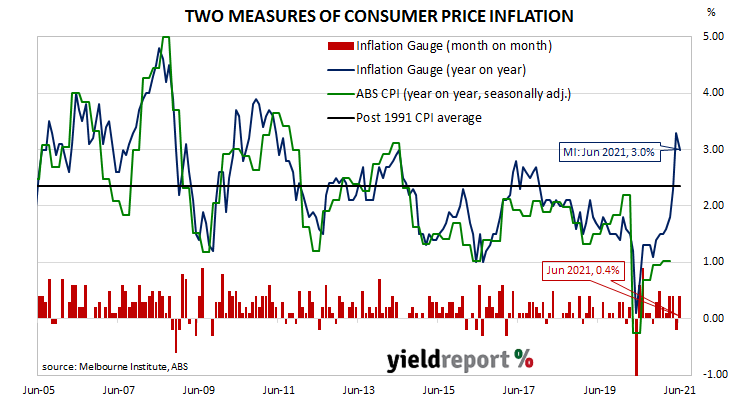Summary: Melbourne Institute inflation rate rises in June; annual rate at 3 per cent, bolstered by July 2020 rebound; implies June quarter reading of 2.9% annual rate.
Despite the RBA’s desire for a higher inflation rate, ostensibly to combat recessions, attempts to accelerate inflation through record-low interest rates have failed to date. The RBA’s stated objective is to achieve an inflation rate of between 2% and 3%, “on average, over time.” Australia’s inflation rate has been trending lower and lower since the GFC and the “coronavirus recession” then crushed it in the June quarter of 2020.
The Melbourne Institute’s latest reading of its Inflation Gauge index increased by 0.4% in June, following a 0.2% fall in May and a 0.4% increase in April. On an annual basis, the index rose by 3.0%, slowing from May’s comparable figure of 3.3%. However, a 0.9% rise in July 2020 accounts for nearly one third of the annual increase.

The figures were released on the same day as ANZ’s latest Job Ads report and Commonwealth Government bond yields fell on the day. By the close of business, the 3-year ACGB yield had slipped 1bp to 0.42%, the 10-year yield had shed 5bps to 1.44% while the 20-year yield finished 1bps lower at 2.04%.
The Melbourne Institute’s Inflation Gauge is an attempt to replicate the ABS consumer price index (CPI) on a monthly basis. It has turned out to be a reliable leading indicator of the CPI, although there are periods in which the Inflation Gauge and the CPI have diverged for as long as twelve months. On average, the Inflation Gauge’s annual rate tends to overestimate the ABS headline rate by around 0.1% on average.
Given the Inflation Gauge’s tendency to overestimate, the latest figures imply an official CPI reading of 0.1% (seasonally adjusted) for the June quarter or 2.9% in annual terms. However, it is worth noting the annual CPI rate to the end of March 2019 was 1.3% when the Inflation Gauge had implied a 2.0% annual rate.

